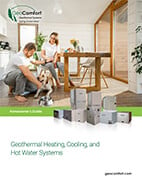It’s been a tough day for Jerri—nausea, irritated eyes, scratchy throat, headache, fatigue. She can’t wait to leave the office and head straight to bed. Remarkably, when she pulls into her driveway 25 minutes later, she feels fine. Others who work in Jerri’s building suffer the same symptoms at work and welcome the same relief once they leave.
What’s up? Likely Sick Building Syndrome (SBS), according to the U.S. Environmental Protection Agency. SBS, they say, occurs when building occupants experience acute health and comfort effects that seem linked to time spent in a building.
The strange part? No specific illness or cause can be identified.
Research tells us:
- Signs of SBS occur in 30% of new or remodeled office buildings.
- Workers who experience symptoms like Jerri’s perform with a 20% reduction in productivity.
SICK BUILDING SYNDROME VS. BUILDING-RELATED ILLNESSES
SBS differs from Building-related Illnesses (BRI) in terms of specificity. With SBS, no specific illness or cause can be identified. Here’s an example:
Sick Building Syndrome – Renfrew County Courthouse in Ontario, Canada, during the 1990s. Workers report headaches, dizziness, and respiratory issues. Investigations reveal poor ventilation, poor indoor air quality, and high levels of formaldehyde from building materials. Still, authorities can’t confirm a clear cause-effect relationship.
With BRI, symptoms of a diagnosable illness and their cause can be identified. Here’s an example:
Building-related Illness – Belleview Stratford Hotel in Philadelphia, Pennsylvania, 1976. Dozens of convention-goers experience a serious form of an atypical pneumonia. Out of 182 persons hospitalized, 29 die. Health officials traced the infection to water in the building’s air conditioning system, a reservoir for the bacterium Llegionella pneumophila.
WHAT’S BEHIND SICK BUILDING SYNDROME?
The National Institute for Occupational Safety and Health identifies a building as sick if 20% of its workforce experiences symptoms, and the symptoms diminish when the workers are away. Contributing factors may include
- Humidity and dust;
- Electromagnetic radiation emitted by electronics like microwaves and computers;
- Biologic contaminants like pollen, bacteria, mold, and viruses; and
- Chemical contaminants like radon, formaldehyde, and asbestos.
Paint, adhesives, and treated fibers in carpeting and upholstery can emit or “off-gas” volatile organic compounds (VOCs) that have also been associated with SBS.
SICK HOMES – IS YOUR HOME ONE OF THEM?
Sick Building Syndrome is typically associated with commercial buildings, but it can affect homes as well, even new homes.
Foam insulation and manufactured woods, plywood, and pressboard used in new home construction emit formaldehyde that can take up to two years to go away. Flooring, adhesives and glues, polyurethane spray foam and finishes, and paint fumes all compromise air quality. You probably know it as “that new house smell.”
If you own a newly constructed home, some industry professionals recommend that you conduct a chemical “bake out” before moving in. This means heating your unoccupied home to a high temperature (85-90 degrees) for a few days to speed up the off-gassing process. Then blow the gasses out via fans placed at open windows.
DIY detection kits can also help you identify factors that may potentially compromise your home’s health. Check your local hardware or home improvement center for in-home test kits that measure levels of dust, mold, radon, electromagnetic radiation, VOCs, and formaldehyde.
Home indoor air quality monitors also detect a range of indoor pollutants, VOCs, and carbon dioxide.
AIR QUALITY AND VENTILATION
Sick Building Syndrome is usually associated with poor air quality and ventilation, reason to carefully consider how we heat and cool our homes.
If replacing your furnace is an option, consider a ground source heat pump system (also known as a geothermal heat pump system). These systems quietly absorb heat that’s stored in the earth and transfer it to living spaces. Unlike gas and oil furnaces, they don’t require combustion, which means they don’t release carbon monoxide or soot into your home.
Go here to learn more about healthy heating and cooling:
Ron and Lynda’s Healthy Canadian Duplex
Michael & Emily’s Healthy Home
Kids, Allergies, and Air Quality in Your Home -How Geothermal Heating and Cooling Can Help
